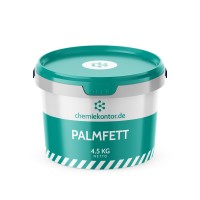Palm fat - what to watch out for
What is palm fat?
Palm fat is obtained from the pulp of the oil palm. It consists of half saturated fats and is a synonym for palm oil
Where is palm fat found?
Palm oil is used in large parts of Asia and Africa as an edible oil for cooking, frying and deep-frying due to its outstanding heat and oxidation stability. It is also found in baked goods, confectionery and margarine. Furthermore, palm fat and its derivatives can be found in various formulations for the cosmetics industry and detergents. In technology, it is a fundamental substance for the production of numerous oleochemical products, which are used in lubricants or candles, among other things.
Where does palm oil come from?
The largest producing countries of palm oil are Indonesia, Malaysia, Thailand and Colombia, where it is mostly produced conventionally. However, for some years now, palm oil has also been grown sustainably in large quantities on RSPO-certified land. The abbreviation RSPO stands for (The) Roundtable of Sustainable Palm Oil. This is an organization founded by the WWF, which has set itself the goal of making the production of palm oil more sustainable. This includes, among other things, ensuring that no clearing of specially protected forests takes place, that laws (land use and property rights) are observed, that a responsible approach to ecosystems and their environment is guaranteed, and that plantations are as small as possible on sensitive soils. According to the RSPO's own figures, 19% of global palm oil production and approximately 2.9 million hectares are now RSPO-certified.
How is palm oil produced?
Palm oil is produced by a sterilization and pressing process of the pulp. This is how the palm oil or palm fat is obtained. Initially, the palm oil is still orange-yellow to brownish red, as it still has a very high carotene content at this stage. However, the carotene is removed by refining, which leaves the light shade.



